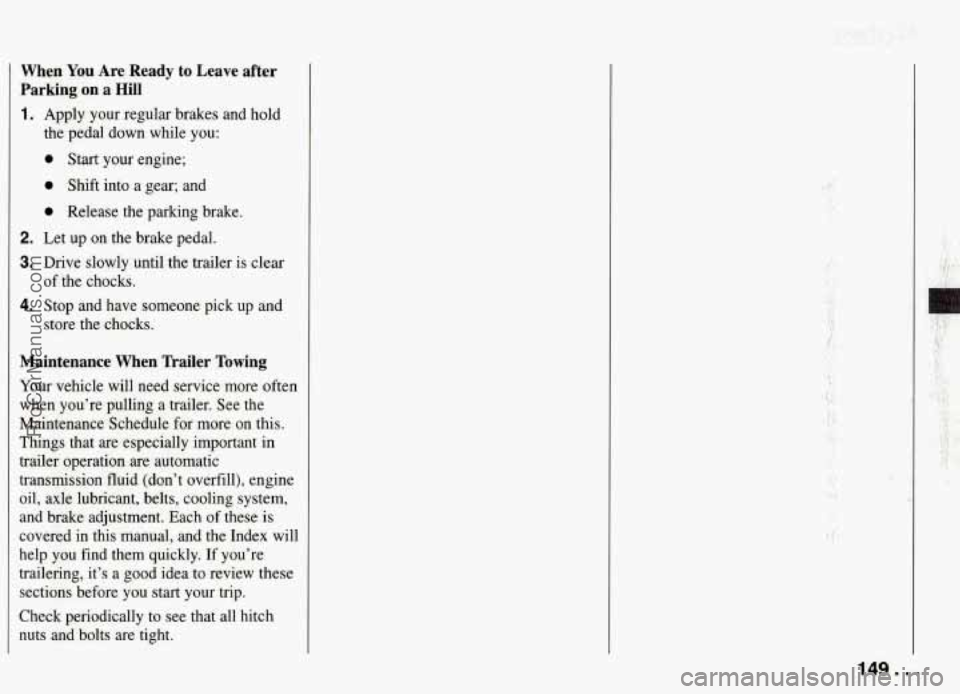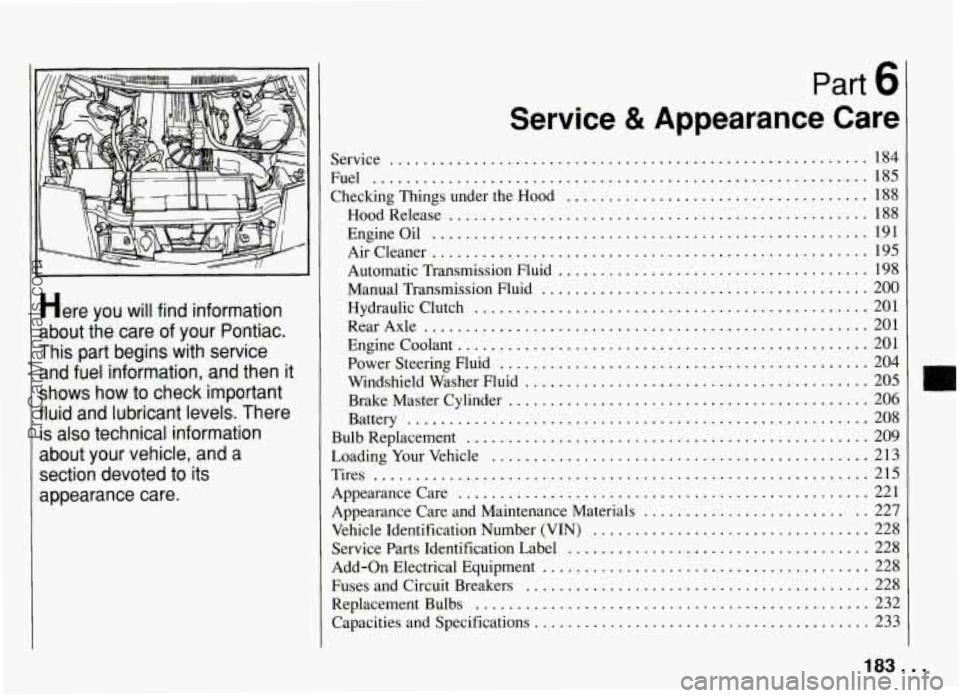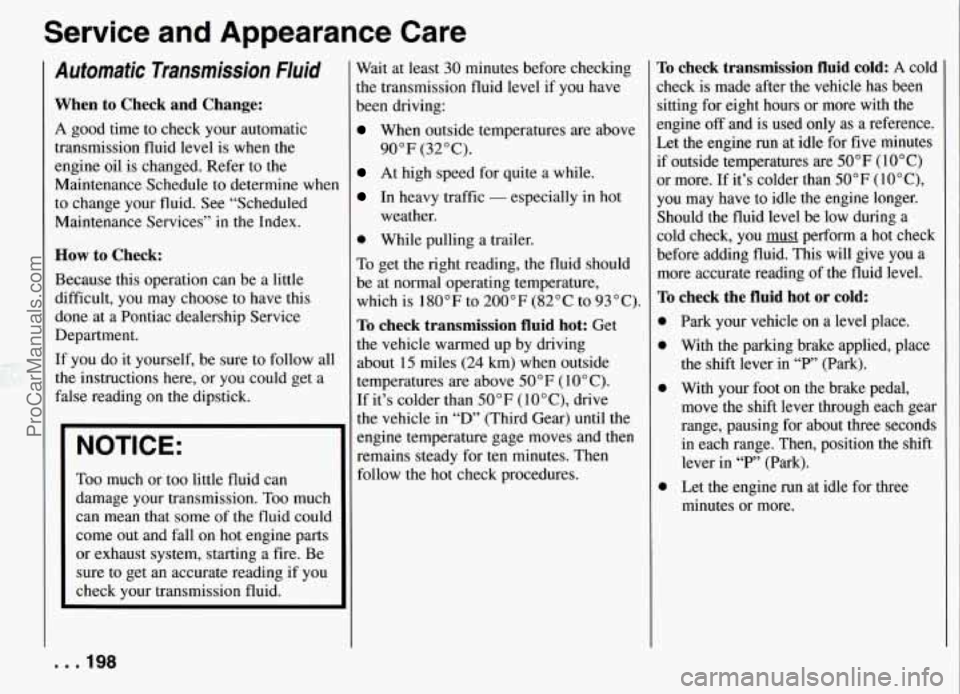check engine PONTIAC FIREBIRD 1994 User Guide
[x] Cancel search | Manufacturer: PONTIAC, Model Year: 1994, Model line: FIREBIRD, Model: PONTIAC FIREBIRD 1994Pages: 290, PDF Size: 14.84 MB
Page 149 of 290

Your Driving and the Road
Backing Up
Hold the bottom of the steering wheel
with one hand. Then, to move the trailer
to the left, just move that hand to the left.
To move the trailer to the right, move
your hand to the right. Always back up
slowly and, if possible, have someone
guide you.
Making 7hms
When you’re turning with a trailer, make
wider turns than normal.
Do this so your
trailer won’t strike soft shoulders, curbs,
road signs, trees, or other objects. Avoid
jerky or sudden maneuvers. Signal well in
advance.
Thrn Signals When Towing a Trailer
When you tow a trailer, your vehicle has
to have a different turn signal flasher and
extra wiring. The green arrows on your
instrument panel will flash whenever you signal a turn or lane change. Properly
hooked up, the trailer lights will also
flash, telling other drivers you’re about to
turn, change lanes or stop. When
towing a trailer, the green arrows
on your instrument panel will flash for
turns even
if the bulbs on the trailer are
burned out. Thus, you may think drivers
behind you are seeing your signal when
they are not. It’s important to check
occasionally to be sure the trailer bulbs
are still working.
Driving on Grades
Reduce speed and shift to a lower gear
before you start down a long or steep
downgrade. If you don’t shift down, you
might have to use your brakes
so much
that they would get hot and no longer
work well.
On a long uphill grade, shift down and
reduce your speed to around
45 mph
(70 km/h) to reduce the possibility of
engine and transmission overheating.
If you are towing a trailer and you
have an automatic transmission with
Overdrive, you may prefer to drive in
“D”
instead of Overdrive (or, as you need to, a
lower gear). Or,
if you have a manual
transmission with fifth (or sixth) gear and
you are towing a trailer, it’s better not to
use fifth (or sixth) gear. Just drive in
fourth gear (fifth gear if you have a six-speed manual transmission) or, as you
need to, a lower gear.
Parking on Hills
You really should not park your vehicle,
with a trailer attached, on a hill. If
-
something goes wrong, your rig could
start to move. People can be injured, and
both your vehicle and the trailer can be
damaged.
But if you ever have to park your rig on a
hill, here’s how to do it:
1. Apply your regular brakes, but don’t
shift into
“P” (Park) yet, or into gear
for a manual transmission.
2. Have someone place chxks under the
3. When the wheel chocks are in place,
release the regular brakes until the
chocks absorb the load. trailer wheels.
4. Reapply the regular brakes. Then
apply your parking brake, and then shift to
“P” (Park), or “R” (Reverse)
for a manual transmission.
5. Release the regular brakes.
. . .I48
ProCarManuals.com
Page 150 of 290

When You Are Ready to Leave after
Parking on a
Hill
1. Apply your regular brakes and hold
the pedal down while you:
0 Start your engine;
0 Shift into a gear; and
0 Release the parking brake.
2. Let up on the brake pedal.
.
3. Drive slowly until the trailer is clear
4. Stop and have someone pick up and
of the chocks.
store the chocks.
Maintenance When Trailer Towing
Your vehicle will need service more often
when you're pulling a trailer. See the
Maintenance Schedule for more on this.
Things that are especially important in
trailer operation are automatic
transmission fluid (don't overfill), engine
oil, axle lubricant, belts, cooling system,
and brake adjustment. Each of these
is
covered in this manual, and the Index will
help you find them quickly. If you're
trailering, it's a good idea to review these
sections before you start your trip.
Check periodically to see that all hitch
nuts and bolts .are tight.
I
I
149.. .
ProCarManuals.com
Page 155 of 290

Problems on the Road
Find the positive (+) and negative (-)
terminals on each battery. 5. Check that the jumper cables don’t
have loose
or missing insulation. If
they do, you could get a shock. The
vehicles could be damaged, too.
Before
you connect the cables, here
are some basic things
you should
know. Positive
(+) will go to positive
(+) and negative (-) will go to
negative
(-) or a metal engine part.
Don’t connect
(+) to (-) or you’ll get a
short that would damage the battery
and maybe other parts, too.
. . .I54
ProCarManuals.com
Page 164 of 290

On the V8 engine you’ll see this:
1. Coolant recovery tank
2. Radiator pressure cap
3. Electric engine fans
If the coolant inside the coolant recovery
tank is boiling, don’t do anything else
until it cools down.
When it
is cool, remove the coolant
recovery tank cap and look at the dipstick.
The coolant level should be at
or above
“FULL
COLD.” If it isn’t, you may have
a leak in the radiator hoses, heater hoses,
radiator, water pump or somewhere else
in the cooling system.
NOTICE:
Engine damage from running your
engine without coolant isn’t covered
by your warranty.
If there seems to be no leak, check to see
if the electric engine fan is running. If the
engine
is overheating, the fan should be
running.
If it isn’t, your vehicle needs
service.
163..
ProCarManuals.com
Page 184 of 290

I I
Here you will find information
about the care of your Pontiac
.
This part begins with service and fuel information. and then
it
shows how to check important
fluid and lubricant levels
. There
is also technical information
about your vehicle. and a section devoted
to its
appearance care
.
Part b
Service 8t Appearance Care
Service .........................................................
Fuel ...........................................................
Checking Things under the Hood ....................................
HoodRelease ..................................................
184
185
188
188
Engineoil
.................................................... 191
Aircleaner
.................................................... 195
Automatic Transmission Fluid
..................................... 198
Manual Transmission Fluid
....................................... 200
Hydraulic Clutch
............................................... 201
RearAxle
..................................................... 201
Enginecoolant
................................................. 201
Power Steering fluid
............................................ 204
Windshield Washer Fluid
......................................... 205
Brake Master Cylinder
........................................... 206
Bulb Replacement
................................................ 209
Battery
....................................................... 208
LoadingYourVehicle
............................................. 213
Tires
........................................................... 215
Appearance Care
................................................. 221
Appearance Care and Maintenance Materials
.......................... 227
Vehicle Identification Number (VIN)
................................. 228
Service Parts Identification Label
.................................... 228
Add-on Electrical Equipment
....................................... 228
Fuses and Circuit Breakers
......................................... 228
ReplacementBulbs
............................................... 232
Capacities and Specifications
........................................ 233
183 ...
ProCarManuals.com
Page 187 of 290

Service and Appearance Care
NOTICE:
Fuel that is more than 5% methanol
is bad for your vehicle. Don’t use it.
It can corrode metal parts in your fuel
system and also damage plastic and
rubber parts. That damage wouldn’t
be covered under your warranty. And
even at
5% or less, there must be
“cosolvents” and corrosion prevent-
ers in this fuel to help avoid these
problems.
Gasolines for Cleaner Air
Your use of gasoline with deposit control
additives will help prevent deposits from
forming in your engine and fuel system.
That helps keep your engine in tune and
your emission control system working
properly. It’s good for your vehicle, and
you’ll be doing your part for cleaner air.
Many gasalines are now blended with
oxygenates. General Motors recommend:
that you use gasolines with these blendin,
materials, such as MTBE and ethanol. BJ
doing
so, you can help clean the air,
especially
in those parts of the country
that have high carbon monoxide levels. n
addition, some gasoline suppliers are
low producing reformulated gasolines.
rhese gasolines are specially designed to
.educe vehicle emissions. General Motors
-ecommends that you use reformulated
;asoline. By doing
so, you can help clean
:he air, especially in those parts of the
:ountry that have high ozone levels.
You should ask your service station
3perators if their gasolines contain deposit
:ontrol additives and oxygenates, and
if
:hey have been reformulated to reduce
vehicle emissions.
Fuels in Foreign Countries
[f you plan on driving in another country
outside the
U.S. or Canada, unleaded fuel
may be hard to find. Do not use leaded
gasoline, If you use even one tankful,
your emission controls won’t work well
or at all. With continuous use, spark plugs
can get fouled, the exhaust system can
corrode, and your engine oil can
deteriorate quickly. Your vehicle’s oxygen
sensor will be damaged. All of that means
costly repairs that wouldn’t be covered by
your warranty.
To check on fuel availability, ask an auto
:lub, or contact a major oil company that
Joes business in the country where you’ll
,e driving.
You can also write us at the following
iddress for advice. Just tell
us where
you’re going and give your Vehicle
Identification Number (VIN).
General Motors Overseas Distribution
North American Export Sales (NAES) 1908 Colonel Sam Drive
Oshawa, Ontario
LlH 8P7
Canada Corporation
. . .I86
ProCarManuals.com
Page 192 of 290

OIL
Engine Oii
If the “LOW OIL” light on the instrumenl
panel comes on, it means you need to
check your engine oil level right away.
For more information, see
“Low Oil
Light”
in the Index. You should check
your engine oil level regularly; this is an
added reminder.
3.4L L32 (Code S)
It’s a good idea to check your engine oil
every time you get fuel. In order to get an
accurate reading, the oil must be warm
and the vehicle must be on level ground.
5.7L LTl (Code P)
Turn off the engine and give the oil a few
ninutes to drain back into the oil pan. If
’ou don’t, the oil dipstick might not show
he actual level.
191 ...
ProCarManuals.com
Page 193 of 290

Service and Appearance Care
To Check Engine Oil
(3.4L L32 (Code S) Engine)
Pull out the dipstick and clean it with a
paper towel or cloth, then push it back
in
all the way. Remove it again, keeping the
tip lower, and check the level.
To Check Engine Oil
(5.7L LT1 (Code P) Engine)
Pull out the dipstick slightly. Pinch the
end of the dipstick tube as you remove
the dipstick to wipe the oil from it. Then
push it all the way back in. Now remove
it without pinching the tube, keeping the
tip lower.
3.4L L32 (Code S)
When to Add Oil:
If the oil is at or below the “ADD’ line,
then you’ll need to add some oil. But
you must use the right kind. This section
explains what kind of oil to use. For
crankcase capacity, see “Capacities and Specifications” in the Index.
. . .I92
ProCarManuals.com
Page 199 of 290

Service and Appearance Care
Automatic Transmission Fluid
When to Check and Change:
A good time to check your automatic
transmission fluid level
is when the
engine oil is changed. Refer to the
Maintenance Schedule to determine when
to change your fluid. See “Scheduled
Maintenance Services” in the Index.
How to Check:
Because this operation can be a little
difficult, you may choose to have this
done at a Pontiac dealership Service
Department.
If you do it yourself, be sure to follow all
the instructions here, or
you could get a
false reading on the dipstick.
Too much or too little fluid can
damage your transmission. Too much
can mean that some of the fluid could
come out and fall on hot engine parts
or exhaust system, starting a fire. Be
sure to get an accurate reading
if you
check your transmission fluid. Wait
at least 30 minutes before checking
the transmission fluid level if you have
been driving:
When outside temperatures are above
At high speed for quite a while.
In heavy traffic - especially in hot
90°F (32°C).
weather.
While pulling a trailer.
To get the right reading, the fluid should
be at normal operating temperature,
which is 180°F to 200°F (82°C to 93°C).
To check transmission fluid hot: Get
the vehicle warmed up by driving
about
15 miles (24 km) when outside
temperatures
are above 50°F ( 10°C).
If it’s colder than 50°F ( lO”C), drive
the vehicle in
“D’ (Third Gear) until the
engine temperature gage moves and then
remains steady for
ten minutes. Then
follow the hot check procedures.
To check transmission fluid cold: A cold
check is made after the vehicle has been
sitting for eight hours or more with the
engine
off and is used only as a reference.
Let the engine run at idle for five minutes
if outside temperatures are 50°F
(10°C)
or more. If it’s colder than 50°F (lO°C),
you may have to idle the engine longer.
Should the fluid level be low during a
cold check, you must perform a hot check
before adding fluid. This will give you a
more accurate reading of the fluid level.
To check the fluid hot or cold:
0
Park your vehicle on a level place.
With the parking brake applied, place
the shift lever
in “P” (Park).
With your foot on the brake pedal,
move the shift lever through each gear
range, pausing for about three seconds
in each range. Then, position the shift
lever in “P” (Park).
Let the engine
run at idle for three
minutes or more.
. . .I98
ProCarManuals.com
Page 200 of 290

3.4L L32 (Code S)
Then, without shutting off the engine,
follow these steps:
1. Pull out the dipstick and wipe it with a
clean rag or paper towel.
1.7L LTI (Code P)
2. Push it back in all the way, wait three
seconds and then pull it back out
again.
3. Check both sides of the dipstick, and
i-ead the lower level. The fluid level
must be in the “COLD” area
for a colc
check
or in the “HOT” area or
cross-hatched area for
a hot check.
4. If the fluid level is in the acceptable
range. push the dipstick back
in all the
way.
How to Add Fluid:
Refer to the Maintenance Schedule to
determine what kind
of transmission fluid
to use. See “Recommended Fluids and
Lubricants”
in the Index.
199 ...
ProCarManuals.com